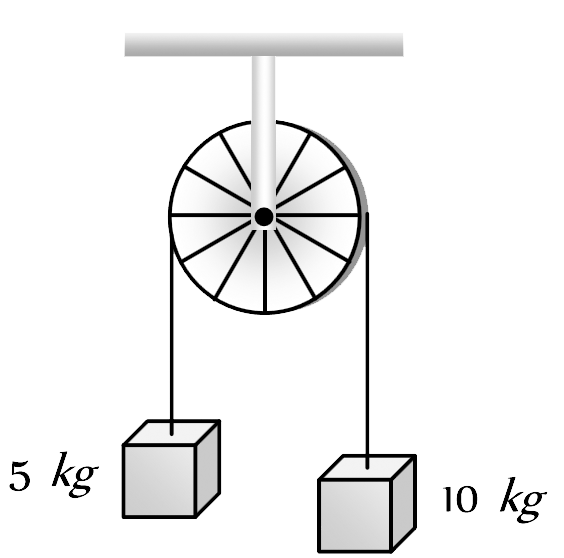If acceleration of A is 2m/s2 to left and acceleration of B is 1m/s2 to left, then acceleration of C is-
 Solution in Gujrati
Solution in Gujrati
1m/s2 downwards
1m/s2 upwards
2m/s2 downwards
2m/s2 upwards
The correct Answer is:B

l1+l2+l3+l4+l5= constant
⇒l1+l2+l3+l4+l5=0
⇒aC+aA+(aA−aB)+(−aB)+aC=0
rAa2aC+2aA−2aB=0
⇒aC=aB−aA=1−2=−1ms−2 upwards
Topper's Solved these Questions
- NEWTONS LAWS OF MOTIONBOOK - ALLEN CHAPTER - NEWTONS LAWS OF MOTIONEXERCISE - EXERCISE-III
28 Videos
- NEWTONS LAWS OF MOTIONBOOK - ALLEN CHAPTER - NEWTONS LAWS OF MOTIONEXERCISE - EXERCISE-I
52 Videos
- NEWTON'S LAWS OF MOTION & FRICTIONBOOK - ALLEN CHAPTER - NEWTON'S LAWS OF MOTION & FRICTIONEXERCISE - EXERCISE (JA)
4 Videos
- RACEBOOK - ALLEN CHAPTER - RACEEXERCISE - Basic Maths (Wave Motion & Dopplers Effect) (Stationary waves & doppler effect, beats)
25 Videos
Similar Questions
Assertion: The driver in a vechicle moving with a constant speed on a straight road is in a non-inertial frame of referance.
Reason: A reference frame in which Newton's laws of motion are applicable is non-inertial.
View SolutionUSS 150) Two masses of 5 kg and 10 kg are connected to a pulley as shown. What will be the acceleration of the system (g= acceleration due to gravity)

View SolutionA piece of wire is bent in the shape of a parabola y=kx2 (y-axis vertical) with a bead of mass m on it. The bead can slide on the wire without friction. It stays at the lowest point of the parabola when the wire is at rest. The wire is now accelerated parallel to the x-axis with a constant acceleration a. The distance of the new equilibrium position of the bead, where the bead can stay at rest with respect to the wire, from the y-axis is:
View SolutionThe frequency of a radar is 780 MHz. After getting reflected from an approaching aeroplane, the apparent frequency is more than the actual frequency by 2.6 kHz. The aeroplane has a speed of
View SolutionIn the figure acceleration of A is 1m/s2 upward, acceleration of B is 7m/s2 upward acceleration of C is 2m/s2 upward. The acceleration of D will be.

View SolutionFind the acceleration of movable pulled P and block B if acceleration of block A =1m//s^(2)darr .
View SolutionIf acceleration of block B is 4m/s2 upward & that of C is 6m/s2 downward. Find acceleration of A :−

View SolutionBlock C shown in figure-1.79 is going down at acceleration 2 m//s^(2) . Find the acceleration of blocks A and B.
View SolutionWedge B is pulled by an acceleration 2g towards left. Find the acceleration of block A-
View SolutionIf acceleration of A is 2m//s^(2) which is smaller than acceleration of B then the value of frictional force applied by B on A is
View SolutionIn the figure shown, the acceleration of block of mass m_(2) is 2m//s^(2) . The acceleration of m_(1) :
View Solutionकिसी 10g के द्रव्यमान में 5m/s2 का त्वरण उत्पन्न करने में अधिक बल की आवश्यकता होगी या 20g द्रव्यमान में 2m/s2 का त्वरण उत्पन्न करने में ?
View SolutionIf S2=at2+2bt+c, then the acceleration is :
View SolutionIf S2=at2+2bt+c then the acceleration is
View Solutionदो कारे एक दौड़ प्रतियोगिता में विरामावस्था में सरल में क्रमशः 2m/s और 4m/s के वेग से गति प्रारम्भ करती है। उनके त्वरण क्रमशः 2m/s2 और 1m/s2 है।
View SolutionA bus can accelerate with an acceleration 1m/s2. Find the minimum time for the bus to reach the speed of 100 km/s from 50 km/s.
View Solution
